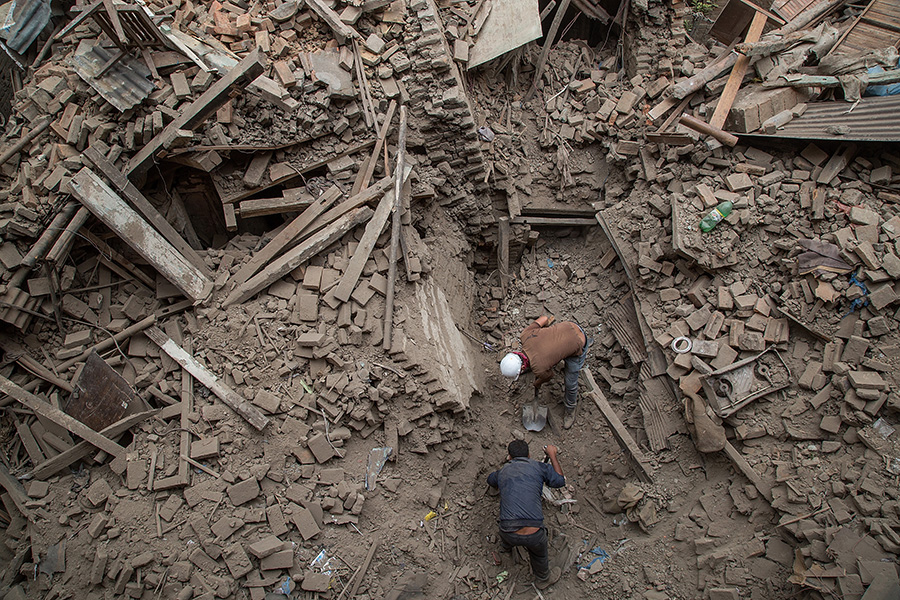April 23-29, 2015, Current Events Lesson Plan
Current Event: Thousands Dead or Injured in Nepal
Thousands of people in died as a result of a powerful 7.8 magnitude earthquake that struck Nepal on April 25. The epicenter of the quake was some 50 miles northwest of Nepal’s capital city Kathmandu. The capital was badly hit by the earthquake; many people were killed, others buried in rubble, and many landmark buildings were destroyed. The aftershocks were also very strong, some of them at a magnitude of 6.7. The earthquake caused an avalanche on Mount Everest, the world’s highest mountain, which obliterated many of the dozens of tents that form the base camp used by climbers, and killed 18 people. Hospitals in Kathmandu were overwhelmed by the size of the disaster, and patients lay outside of the hospital with IV drips in their arms when there were no more beds available. Because of Nepal’s geography and the continuing aftershocks, rescue efforts were difficult and humanitarian aid from other nations had not yet reached Nepal a day later. The situation in the rural regions nearer to the epicenter were not known, as travel in the mountainous areas is difficult at the best of times.

Two men help clear debris after buildings collapsed on April 26, 2015 in Bhaktapur, Nepal. A major 7.8 earthquake hit Kathmandu mid-day on Saturday, and was followed by multiple aftershocks that triggered avalanches on Mt. Everest that buried mountain climbers in their base camps. Many houses, buildings and temples in the capital were destroyed during the earthquake, leaving thousands dead or trapped under the debris as emergency rescue workers attempt to clear debris and find survivors. (Credit: © Omar Havana, Getty Images)
Objective:
An earthquake is a shaking of the ground caused by a sudden shift in Earth’s rocky outer shell. A severe earthquake may release 10,000 times as much energy as did the first atomic bomb. The shaking can damage buildings, bridges, and other structures so badly that they fall down. Earthquakes can also cause avalanches, landslides, and tsunamis. Scientists think that several million earthquakes occur every year. However, only about 150 are strong enough to cause significant loss of life. Earthquakes almost never kill people directly. Instead, they cause death or injury through falling objects and the collapse of buildings, bridges, and other structures. Scientists cannot predict the exact time, place, and magnitude of an earthquake. However, they can often make forecasts about the likelihood of a strong quake for regions with well-known earthquake histories. The Behind the Headlines news story and related World Book articles explore earthquakes and other natural disasters.
Words to know:
- Disaster
- Earthquake
- Himalaya
- Kathmandu
- Moment magnitude
- Mount Everest
- Nepal
- Richter magnitude
- Seismology
Discussion Topics:
1. Ask your students what they know about Nepal. (They might say Nepal is in Asia; Kathmandu is the country’s capital and largest city; Mount Everest, the highest mountain in the world, is on Nepal’s border with Tibet; the Himalaya cover most of the country; most of the country’s people are farmers; most of the country’s people are Hindu.)
2. Ask your students what they can do to protect themselves in an earthquake. (Students might say that they can drop to the ground and take cover under a table or other sturdy piece of furniture; stay away from windows or anything that could fall, such as a bookcase; stay inside until you are sure it is safe to exit; or move away from buildings, if outside.)
3. Ask your students to debate, “Schools should be required to teach students how to prepare for various natural disasters.”
4. Earthquakes, floods, hurricanes, tornadoes, and other natural disasters are common throughout the world. Ask your students which natural disaster they think is the most dangerous.
5. Ask your students to debate, “The United Nations should collect money from member nations and become the main source of all future disaster relief.”
6. Ask your students to use World Book’s Timelines feature to view or add to the Major Disasters timeline.


